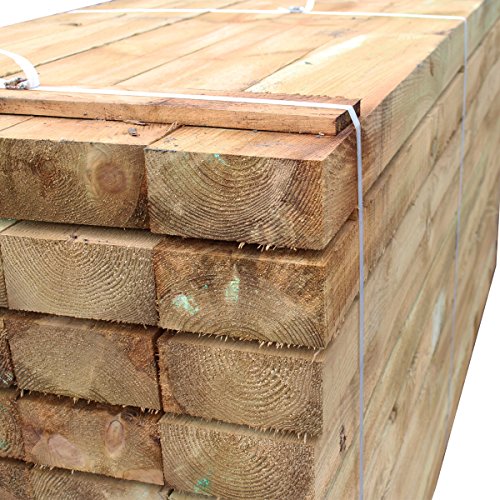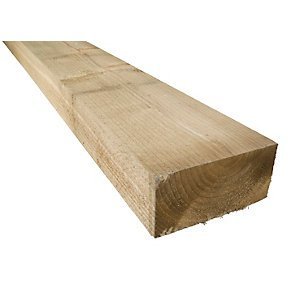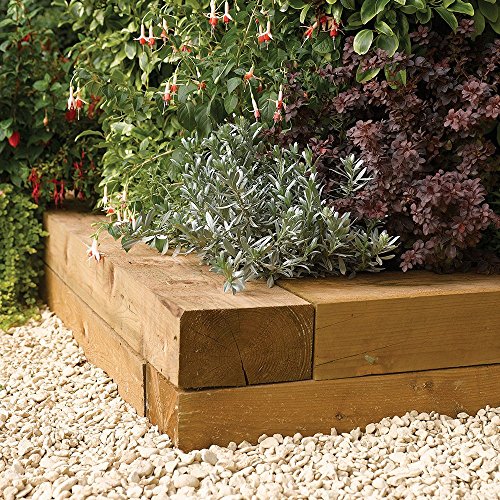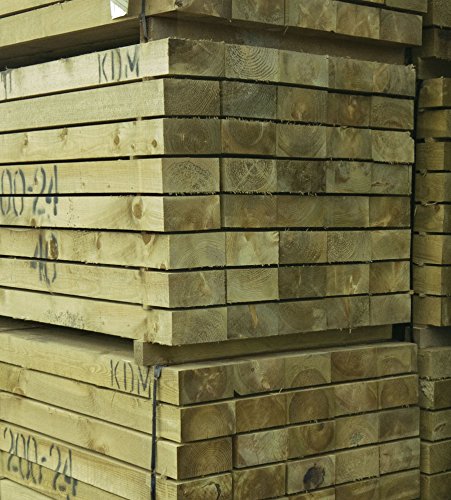We’re always on the lookout for original, practical and innovative gardening ideas. But every once in a while, nature restrtuctures herself to give us something unexpected and evironmentally friendly to work with. Generally used to support, maintain, and align the tracks on a rail, railway sleepers have seen a massive revival due to their ruggedness and versatility.
In case you’re wondering if there’s a train coming through UK homeowners’ yards, railway sleepers have found a myriad of new uses. Whether hardwood or softwood, wooden sleepers have become incredibly popular; especially reclaimed ones that give your garden and yard a traditional, rustic look.
One of the common ways to use railway sleepers include as raised flower planters or vegetable beds which are ideal for drainage and pest control. Likewise, the sleepers also make great and easy to install garden steps and plot edging. And if you’re an advanced DIYer, why not give custom garden furniture a hand? There are some beautiful chairs, benches, tables, and even decking made entirely from railway sleepers.
Key Considerations When Buying Railway Sleepers for Your Garden
i) Railway Sleeper Material
Railroad sleepers or ties come in a variety of materials and types. These include stone blocks, pre stressed concrete, steel, plastic, and wooden ties. Since we’re interested in gardening and landscaping, it’s best to keep the weight and cost down by going for wooden sleepers. Here. You’ll have the choice of new or reclaimed hardwood and softwood.
ii) Softwood Vs Hardwood
Lightweight, smaller, and easier to maneuver, softwood railway sleepers are a favorite among DIYers. They are easy to handle, drill, and saw through with little effort.
Hardwood rail ties have a much higher density making them heavier and tougher. This means they are ideal for making permanent garden structures that last longer even when in direct contact to wet ground.
iii) Treatment
Untreated railroad sleepers are vulnerable to attack by both vermin and decay. Ensure your ties are treated or even preserved for an even longer lifespan.
The Best Railway Sleepers Reviewed
1. Suregreen Softwood Railway Sleepers (Pack of 4)

If you’ve got a sizeable project in mind, you’re going to need a fair amount of railroad ties. Made from traditional softwood timber, Suregreen presents their large, sawn cut rectangular sleepers. The railway sleepers measure 2.4m long each and come in 4 packs totalling at 100Kg.
Compared to reclaimed, old railway ties, these new sawn sleepers have far straighter edges making them easier and neater to stack. All of Suregreen’s timber is tanalized for long lasting protection against water rot, decay, fungus and insect attack for upto 15 years. This gives the wood a green coloration that fades to brown and finally settles at gery. However, any surfaces that you saw through yourself will need to be treated again for total protection.
What I like about it:
- Newly sawn wood offers straighter edges
- Convenient packaging in 4 packs
- Green tanalized treatment
2. Builder Merchant Timber Railway Sleepers

If there’s one thing that we can all agree on, it’s that construction can get quite costly. That’s why ideas like using pre-cut railroad ties can really save you a lot of money and effort. Builder Merchant have an array of quality railroad sleepers at budget friendly prices.
Their 2.4 metre long railway sleepers are robust and have been green treated for protection against vermin and the weather. This makes them ideal for endless garden applications that include contact with the ground such as edgings, boundaries, decks, walkways, and many more. You can choose to stack them, line them, plant them upright as wall supports or place them vertically on the ground.
What I like about it:
- Quality timber meant for external use
- Sustainable wood sourcing that complies with FCS regulations
- Budget friendly price range
3. Rowlinson 1.8m Timberblocks

Today’s gardening ideas are all about saving the planet while making our gardens look great. As green as your yard, Rowlinson 1.8m Timberblocks boast of environmentally friendly, FCS approved timber from fully sustainable sources. So not only do users get a convenient and easy to assemble garden transfromation, they also help save the planet while at it.
These railway sleepers come in packs of two 1.8 metre heavy duty timberblocks that have been treated to protect against the weather and other elements. And thanks to the natural timber finish, the railroad ties add a rustic, decorative look your garden. Whether you’re building a shed, gazebo, decking, garden furniture or children’s playhouses, Rowlinson Timberblocks fit naturally in any outdoor situation.
What I like about it:
- Attractive, natural timber finish
- Fully compliant with FCS sourcing regulations
- Heavy duty pressure treated timber
4. Ruby Softwood Sleepers
One of the main benefits of working with softwood is the ease of use and maneuverability. So if you plan to cut, drill, or even shape wood, softwood is the way to go. Ruby gives us one of the best deals for 8ft long high quality softwood.
The beams measure 2.4m long by 100mm high and 200mm wide and have been pressure treated to give users a strong, durable and long lasting product. This is one of the manufacturers who sell individual railroad sleepers, but you’ll notice that the price gets lower the more sleepers you buy. In addition to being treated, these softwood ties stand out thanks to an aged, rustic finish.
What I like about it:
- Strong, durable high quality softwood
- 8 ft long beams
- Aged rustic timber finish
5. Armstrong Bulk Pack Timber Sleepers
Got a huge commercial construction or renovation project coming up? Or maybe you’re just a DIY enthusiast looking to stock up on affordable material. Whatever the case may be, it’s clear that you’re going to need a lot of railway sleepers. Armstrong has just the package for this type of situation. The Armstrong bulk pack comes in a set of 20 sleepers each measuring 2.4 metres long by 200mm by 100mm.
All timber is sourced from sustainable forests and is FCS certified. In addition to reducing the carbon footprint, the timber used has also been pressure treated and preserved to protect against water rot and fungal decay. But while the Bulk pack from Armstrong has endless gardening, commercial and leisure applications, the manufacturer advices against using it in children’s play grounds and structures.
What I like about it:
- Bulk Pack of 20 railway sleepers
- FCS certified timber sourcing
- Pressure treated to protect against rot, insects, and decay
Frequently Asked Questions
Q: How to fix railway sleepers to the ground?
Because railways sleepers are so big and heavy, you might think that they can just sit on the ground with no need to secure them – but this can be dangerous as they can fall, so it is much better to secure them into the ground.
When fixing railway sleepers to the ground, you should first dig a trench that is half their depth, then “plant” the first one into this trench.
Next, drill 25x75mm holes in the sleepers, at 1m intervals. Tap in some long dowels, 150mm or longer, into these holes, and fix the next sleeper on top, lining up its holes with the dowel.
At the corners, and at 1m intervals, drive long stakes through the sleepers and into the ground (1000x75x75mm), and attach the sleepers to these stakes using coach bolts. This will stabilise your sleepers securely and make sure they won’t slip or fall.
Q: How to lay railway sleepers in the garden?
Railways sleepers can be used to form retaining walls, terraces and steps, because of their size, weight and longevity.
To lay them as edging:
- Dig a shallow trench and line this with a semi dry concrete mix.
- Place the next sleeper on top, using long dowels to secure them together.
- Alternatively, you can use heavy duty timber screws which don’t require pre drilling.
- You can also fix sleepers using galvanised straps that come ready to attach to your sleepers.
- Once you have achieved the weight and shape you want, trim off excess wood and plane any rough edges.
You can also stack your sleepers vertically for adding interest to your garden:
- For the rustic look leave the length at different heights.
- Dig a trench 300mm wide and deep enough to accommodate the sleeper and a bed of at least 50mm concrete.
- Insert the sleepers and bed them in well with the concrete.
Q: How to build a raised bed with railway sleepers?
If you are making raised beds, which is one of the most common uses of railway sleepers, you will need to bury the first sleeper in a trench that is half the depth of the sleeper.
At 1m intervals, sink some long (1000x75x75mm) stakes through the sleepers and into the ground underneath the bed.
Drill some more holes at 1m centres (150x75x75mm) and insert some 150mm long dowels. Drill holes in the following sleepers at the same intervals, then place these over the dowels to keep them secure.
For a raised bed you should then line inside the sleepers with polythene to stop the sleepers’ preservative leaching into the soil, and prevent the soil’s dampness affecting the sleepers.
Q: How to build a retaining wall with railway sleepers?
If you think bricks are too expensive for this, railway sleepers may work too. First, plan your wall and decide where you want to place it, and how high.
Next, clear the area – dig down to firm ground, having removed all the vegetation and ground soil. Level the area down to base soil, leaving gaps for drainage.
Lay the first sleeper bedded flat in the ground, having dug a trench to half the depth of the sleeper. Drive a nail of at least 6 inches through the sleeper to hold it into the ground.
Place the second sleeper on top of the first, adding a 15cm nail at an angle to the joint that sleepers meet, to create a strong wall.
Continue to add sleepers to the wall until it reaches the required height, ad nail them into place. Make sure you treat the exposed areas of the timber with preservatives to keep them strong and resistant to the weather.






